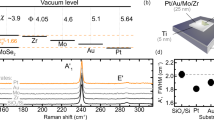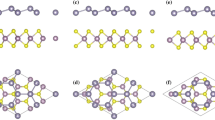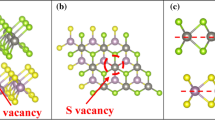Abstract
The electronic structure and optical properties of the MoS2/ZnTe monolayer have been investigated through first-principles calculations. According to the different atoms’ parallelism, we have discussed five interface growth configurations: Te–Mo, Te–S, Hollow, Zn–Mo, and Zn–S systems. It has been shown that the monolayer MoS2/ZnTe exhibits semiconducting behavior and the band gap of MoS2 can be effectively tuned to 1.60 or 1.28 eV in MoS2 and ZnTe heterobilayer. An unexpected direct–indirect band gap transition is also observed, which is dependent on the stacking pattern and interlayer spacing on MoS2. The optical properties of MoS2/ZnTe heterobilayer reflect the phenomenon of red shift. The absorption edge of pure monolayer molybdenum disulfide is 0.8 eV, while the absorption edges of Te–Mo, Te–S, Hollow, Zn–Mo, and Zn–S systems become 0 eV. As a potential material, these provide a possible way to design effective FETs out of MoS2 on a ZnTe monolayer.






Similar content being viewed by others
References
Han SW, Kwon H, Kim SK (2011) Band-gap transition induced by interlayer van der Waals interaction in MoS2. Phys Rev B 84:045409
Lebegue S, Eriksson O (2009) Electronic structure of two-dimensional crystals from ab initio theory. Phys Rev B 79(11):115409
Li T, Galli G (2007) Electronic properties of MoS2 nanoparticles. J Phys Chem C 111(44):16195–16196
Ataca C, Sahin H, Akturk E (2011) Mechanical and electronic properties of MoS2 nanoribbons and their defects. J Phys Chem C 115(10):3934–3941
Mak KF, Lee C, Shan J, Heinx TF (2010) Atomically thin MoS2: a new direct-gap semiconductor. Phys Rev Lett 105:136805
Splendiani A, Sun L, Zhang Y (2010) Emerging photoluminescence in monolayer MoS2. Nano Lett 10(4):1271–1275
Newaz AKM, Prasai D, Ziegler JI (2013) Electrical control of optical properties of monolayer MoS2. Solid State Commun 155:49–52
Hwang H, Kim H, Cho J (2011) MoS2 nanoplates consisting of disordered graphene-like layers for high rate lithium battery anode materials. Nano Lett 11:4826–4830
Eda G, Yamaguchi H, Voiry D, Fujita T, Chen M, Chhowalla M (2012) Photoluminescence from chemically exfoliated MoS2. Nano Lett 11:5111–5116
Bertolazzi S, Brivio J, Kis A (2011) Stretching and breaking of ultrathin MoS2. ACS Nano 5:9703–9709
Friend H, Yoffe A (1973) Layer compounds. Annu Rev Mater Sci 3:147–170
Levy F (1979) Intercalated layered materials. Phys Chem Mater A 6:99–100
Fan XB, Liu F, Yao SY (2012) Preparation of MoS2 nanocatalyst and its application in hydrodesulfurization. J Catal 33:1027–1031
Pollack SS, Makovsky LE, Brown FR (1979) Identification by X-ray diffraction of MoS2 in used CoMoAl2O3 desulfurization catalysts. J Catal 59(3):452–459
Kam KK, Parkinson B (1982) Detailed photocurrent spectroscopy of the semiconducting group VIB transition metal dichalcogenides. J Chem Phys 86(4):463–467
Young PA (1968) Lattice parameter measurements on molybdenum disulphide. J Phys D Appl Phys 1(7):936
Böker T, Severin R, Müller A (2001) Band Structures of MoS2, MoSe2 and a-MoTe2: angular-resolved photoelectron spectroscopy in the constant-final-state mode and ab initio calculations. Phys Rev B 64:235–305
Kim C, Kelty S (2005) Near edge electronic structure in NbS2. J Chem Phys 123:244705
Fang CM, Ettema ARHF, Haas C (1995) Electronic structure of the misfit-layer compound (SnS)1.17NbS2 deduced from band-structure calculations and photoelectron spectra. Phys Rev B 52:2336
Novoselov KS, Jiang D, Schedin F, Booth TJ (2005) Two-dimensional atomic crystals. Proc Natl Acad Sci USA 102:10451–10453
Ayari A, Cobas E, Ogundadegbe O (2007) Realization and electrical characterization of ultrathin crystals of layered transition-metal dichalcogenides. J Appl Phys 101:014507
Yue Q, Chang S, Qin S (2013) Functionalization of monolayer MoS2 by substitutional doping: a first-principles study. Phys Lett A 377(19):1362–1367
Ramasubramaniam A, Naveh D (2013) Mn-doped monolayer MoS2: an atomically thin dilute magnetic semiconductor. Phys Rev B 87(19):195201
Sun QC, Mazumdar D, Yadgarov L (2013) Spectroscopic determination of phonon lifetimes in rhenium-doped MoS2 nanoparticles. Nano Lett 13(6):2803–2808
Li SS, Zhang CW, Yan SS, Hu SJ, Ji WX, Wang PJ, Li P (2014) Novel band structures in silicene on monolayer zinc sulfide substrate. J Phys 26:395003
Tsirlina T, Cohen S (1996) Growth of crystalline WSe2 and WS2 films on amorphous substrate by reactive (Van der Waals) rheotaxy. Sol Energy Mater Sol Cells 44(4):457–470
Jager-Waldau A, Lux-Steiner MC, Bucher E, Jager-Waldau G (1993) WS2 thin films a new candidate for solar cells. In: IEEE conference 1993, p 347026
Blaha P, Schwarz K, Madsen GKH, Kvasnicka D (2001) WIEN2k, an augmented plane wave + local orbitals program for calculating crystal properties. 2001, Karlheinz Schwarz, Techn. Universitat Wien, Austria. ISBN 3-9501031-1-2
Perdew JP, Burke K, Ernzerhof M (1996) Generalized gradient approximation made simple. Phys Rev Lett 77(18):3865
Ye LH, Freeman AJ, Delley B (2006) Half-metallic ferromagnetism in Cu-doped ZnO: density functional calculations. Phys Rev B 73:033203
Xu WB, Huang BJ, Li P, Li F, Zhang CW, Wang PJ (2014) The electronic structure and optical properties of Mn and B, C, N co-doped MoS2 monolayers. Nanoscale Res Lett 9:554
Naeem M, Hasanain SK, Mumtaz A (2008) Electrical transport and optical studies of ferromagnetic Cobalt doped ZnO nanoparticles exhibiting a metal–insulator transition. J Phys 20:025210
Singh N, Jabbour G (2012) Optical and photocatalytic properties of two-dimensional MoS2. J Eur Phys B 85(11):1–4
Shi HL, Pan H (2013) Quasiparticle band structures and optical properties of strained monolayer MoS2 and WS2. Phys Rev B 87(15):155304
Acknowledgements
This work was supported by the National Natural Science Foundation of China (Grant Nos. 61172028 61571210, 11274143, and 11304121) and the Natural Science Foundation of Shandong Province (Grant No. ZR2010EL017).
Author information
Authors and Affiliations
Corresponding author
Ethics declarations
Conflict of interest
The authors declare that they have no conflict of interest.
Rights and permissions
About this article
Cite this article
Chen, Xl., Ji, Wx., Zhang, Cw. et al. Novel optical properties of MoS2 on monolayer zinc tellurium substrate. J Mater Sci 51, 4580–4587 (2016). https://doi.org/10.1007/s10853-016-9771-4
Received:
Accepted:
Published:
Issue Date:
DOI: https://doi.org/10.1007/s10853-016-9771-4




